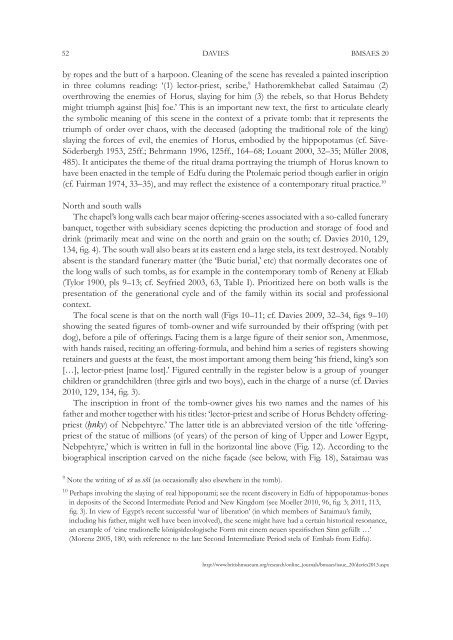The Tomb of Sataimau at Hagr Edfu: An overview - British Museum
The Tomb of Sataimau at Hagr Edfu: An overview - British Museum
The Tomb of Sataimau at Hagr Edfu: An overview - British Museum
You also want an ePaper? Increase the reach of your titles
YUMPU automatically turns print PDFs into web optimized ePapers that Google loves.
52 DAVIES BMSAES 20<br />
by ropes and the butt <strong>of</strong> a harpoon. Cleaning <strong>of</strong> the scene has revealed a painted inscription<br />
in three columns reading: ‘(1) lector-priest, scribe, 9 H<strong>at</strong>horemkheb<strong>at</strong> called <strong>S<strong>at</strong>aimau</strong> (2)<br />
overthrowing the enemies <strong>of</strong> Horus, slaying for him (3) the rebels, so th<strong>at</strong> Horus Behdety<br />
might triumph against [his] foe.’ This is an important new text, the first to articul<strong>at</strong>e clearly<br />
the symbolic meaning <strong>of</strong> this scene in the context <strong>of</strong> a priv<strong>at</strong>e tomb: th<strong>at</strong> it represents the<br />
triumph <strong>of</strong> order over chaos, with the deceased (adopting the traditional role <strong>of</strong> the king)<br />
slaying the forces <strong>of</strong> evil, the enemies <strong>of</strong> Horus, embodied by the hippopotamus (cf. Säve-<br />
Söderbergh 1953, 25ff.; Behrmann 1996, 125ff., 164–68; Louant 2000, 32–35; Müller 2008,<br />
485). It anticip<strong>at</strong>es the theme <strong>of</strong> the ritual drama portraying the triumph <strong>of</strong> Horus known to<br />
have been enacted in the temple <strong>of</strong> <strong>Edfu</strong> during the Ptolemaic period though earlier in origin<br />
(cf. Fairman 1974, 33–35), and may reflect the existence <strong>of</strong> a contemporary ritual practice. 10<br />
North and south walls<br />
<strong>The</strong> chapel’s long walls each bear major <strong>of</strong>fering-scenes associ<strong>at</strong>ed with a so-called funerary<br />
banquet, together with subsidiary scenes depicting the production and storage <strong>of</strong> food and<br />
drink (primarily me<strong>at</strong> and wine on the north and grain on the south; cf. Davies 2010, 129,<br />
134, fig. 4). <strong>The</strong> south wall also bears <strong>at</strong> its eastern end a large stela, its text destroyed. Notably<br />
absent is the standard funerary m<strong>at</strong>ter (the ‘Butic burial,’ etc) th<strong>at</strong> normally decor<strong>at</strong>es one <strong>of</strong><br />
the long walls <strong>of</strong> such tombs, as for example in the contemporary tomb <strong>of</strong> Reneny <strong>at</strong> Elkab<br />
(Tylor 1900, pls 9–13; cf. Seyfried 2003, 63, Table I). Prioritized here on both walls is the<br />
present<strong>at</strong>ion <strong>of</strong> the gener<strong>at</strong>ional cycle and <strong>of</strong> the family within its social and pr<strong>of</strong>essional<br />
context.<br />
<strong>The</strong> focal scene is th<strong>at</strong> on the north wall (Figs 10–11; cf. Davies 2009, 32–34, figs 9–10)<br />
showing the se<strong>at</strong>ed figures <strong>of</strong> tomb-owner and wife surrounded by their <strong>of</strong>fspring (with pet<br />
dog), before a pile <strong>of</strong> <strong>of</strong>ferings. Facing them is a large figure <strong>of</strong> their senior son, Amenmose,<br />
with hands raised, reciting an <strong>of</strong>fering-formula, and behind him a series <strong>of</strong> registers showing<br />
retainers and guests <strong>at</strong> the feast, the most important among them being ‘his friend, king’s son<br />
[…], lector-priest [name lost].’ Figured centrally in the register below is a group <strong>of</strong> younger<br />
children or grandchildren (three girls and two boys), each in the charge <strong>of</strong> a nurse (cf. Davies<br />
2010, 129, 134, fig. 3).<br />
<strong>The</strong> inscription in front <strong>of</strong> the tomb-owner gives his two names and the names <strong>of</strong> his<br />
f<strong>at</strong>her and mother together with his titles: ‘lector-priest and scribe <strong>of</strong> Horus Behdety <strong>of</strong>feringpriest<br />
(Hnky) <strong>of</strong> Nebpehtyre.’ <strong>The</strong> l<strong>at</strong>ter title is an abbrevi<strong>at</strong>ed version <strong>of</strong> the title ‘<strong>of</strong>feringpriest<br />
<strong>of</strong> the st<strong>at</strong>ue <strong>of</strong> millions (<strong>of</strong> years) <strong>of</strong> the person <strong>of</strong> king <strong>of</strong> Upper and Lower Egypt,<br />
Nebpehtyre,’ which is written in full in the horizontal line above (Fig. 12). According to the<br />
biographical inscription carved on the niche façade (see below, with Fig. 18), <strong>S<strong>at</strong>aimau</strong> was<br />
9<br />
Note the writing <strong>of</strong> sS as sSi (as occasionally also elsewhere in the tomb).<br />
10<br />
Perhaps involving the slaying <strong>of</strong> real hippopotami; see the recent discovery in <strong>Edfu</strong> <strong>of</strong> hippopotamus-bones<br />
in deposits <strong>of</strong> the Second Intermedi<strong>at</strong>e Period and New Kingdom (see Moeller 2010, 96, fig. 3; 2011, 113,<br />
fig. 3). In view <strong>of</strong> Egypt’s recent successful ‘war <strong>of</strong> liber<strong>at</strong>ion’ (in which members <strong>of</strong> <strong>S<strong>at</strong>aimau</strong>’s family,<br />
including his f<strong>at</strong>her, might well have been involved), the scene might have had a certain historical resonance,<br />
an example <strong>of</strong> ‘eine tradionelle königsideologische Form mit einem neuen spezifischen Sinn gefüllt …’<br />
(Morenz 2005, 180, with reference to the l<strong>at</strong>e Second Intermedi<strong>at</strong>e Period stela <strong>of</strong> Emhab from <strong>Edfu</strong>).<br />
http://www.britishmuseum.org/research/online_journals/bmsaes/issue_20/davies2013.aspx
















